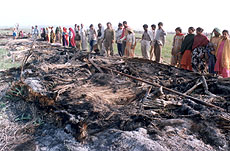Victims of hostile locals
From
Ravi S. Singh
Tribune News Service
SONEPAT, Nov 16 —
Residents of Nangla Behlolpur in Sonepat district are
finding themselves aliens in their own homeland with the
government and the locals refusing to accept them in
their state.
Formerly
located in Baghpat tehsil of Meerut district of
UP, Nangla Behlolpur became part of Haryana after
the Yamuna changed its course. The village was
formally merged with Haryana in September, 1983
when the Haryana and Uttar Pradesh (Alteration of
Boundaries) Act, 1979, became effective.
As the river kept changing its course the
boundaries of the villages in the two states were
affected. |

Residents of
Nangla Beholpur village look at remains of their
belongings, which were set on fire on October 20.
Photo by T. C. Malhotra |
Earlier, the miseries of
the victims of the river were compounded on account of
difference of opinion between the Haryana and Uttar
Pradesh Governments regarding their addresses.
As per the Act a status
quo has been granted to the location of the villages with
regard to maps of the two states, notwithstanding the
changes in their boundaries caused by the Yamuna. In
effect, the concept of "Fluctuating Boundary"
was replaced by "permanent boundary". The Act
was passed on the basis of Dixit award. The award was
based on the Survey of India 1974-75.
Nature’s fury has
left an estimated 1100 persons living in a cluster of 80
makeshift huts homeless and life a daily struggle. The
state government authorities and the locals are
determined to drive them out. On October 20 when the
villagers were forced to take shelter at safer places in
the neighbouring villages after the floods struck their
habitation, they were victims of twin tragedy. Not only
was their daily routine affected by the floods on their
return they found that their hutments had been set ablaze
by hostile neighbours in Khurampur village. The district
administration and the police have turned a deaf ear to
their numerous complaints and no action has yet been
taken against the culprits after the first information
report was filed on the second day of the incident. Also,
no officer of the administration has so for visited the
site.
The Deputy Commissioner,
Sonepat, Mr P.K. Mahapatra, told TNS today that
preventive arrests were made on the day of the incident.
But he expressed ignorance of the situation after the FIR
was lodged. He expressed concern that people took law in
their hand. He further said that a police post had been
set up at Khurampur. The status of the village with
regard to the Haryana and Uttar Pradesh (Alteration of
boundaries) Act was sub judice, he added.
The SP, Sonepat, Mr K.
Selvaraj, said the investigation was still on. A visit to
Nangla Behlolpur revealed that residents had preserved
the ashes and remains of their huts and belongings burnt
in the "arson". The miscreants were accused to
have razed all 80 hutments killing three cattle in the
inferno. The eldest member of the village, Mr Baljit
Singh Yadav, said as many as 12 armed persons from the
neighbouring Khurampur swooped on the hutments in the
evening after opening fire. Except him and two others,
all had left with cattle to safer places as the Yamuna
had flooded the area.
An inquiry revealed that
the residents preferred hutments as the government was
yet to provided "bundh" on the boundaries of
the village to save it from the floods caused by the
river. In absence of a bundh even "pucca"
houses would not be able to stand against possible
floods.
The residents alleged
earlier too there had been acts of aggression from the
residents of Khurampur. According to them, some residents
of Khurampur set three huts on fire, in September, in
collusion with the local police.
They alleged that instead
of taking action against the culprits the police was
siding with them. They further alleged that the police
did not record all aspects of the violent incident on
October 20 with a view to weakening the FIR.
According to them, even
though the Chief Electoral Officer had directed the
district administration to get the names of some persons
of the village registered in the electoral roll of the
village, they were being deprived of their fundamental
right to vote.
The residents of the
village said the reason for the "indifferent"
attitude of the district administration was the pressure
from residents of Khurampur. According to them, residents
of Khurampur had better connections with the bureaucracy
and politicians of Haryana.
Besides, there seems to
economic angle to the situation. As per the revenue
record, Nangla Behlolpur has 254 acres of land. It is
alleged that before the village formally became part of
Haryana, the residents of Khurampur would use the land.
For that matter, they allegedly still use part of the
land by force. Another resident alleged that some
residents of Khurampur had procured an ex parte order
from the court staying the amalgamation of Nangla
Behlolpur with Haryana. The order was procured without
making the residents of Nangla Behlolpur a party to the
case. Following a petition from resident of the village
against the ex parte order, the Punjab and Haryana High
Court on July 14 directed the lower court to settle the
case within one year.
|

